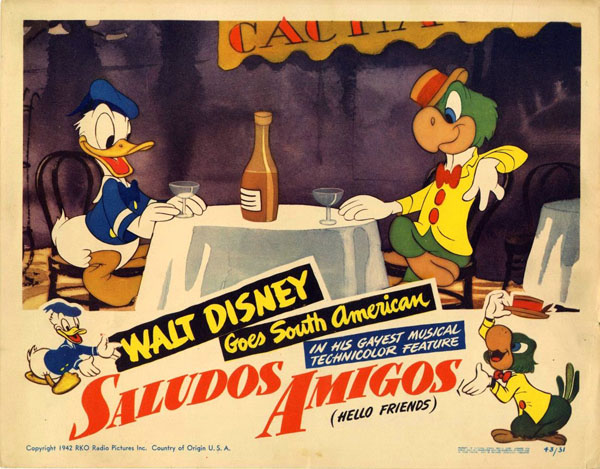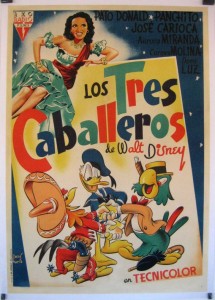
In 1941, the United States government asked Walt Disney to make a goodwill tour of Central and South America with the hope that the magic of the Disney and the universality of the characters would help convince the Latin American people to support the United States during World War II.
To sweeten the offer to Walt, the government offered to underwrite $70,000 in tour expenses and to advance up to $50,000 each for the production of five short cartoons focusing on the countries Walt would visit.
With the Disney Studios deeply in debt because of closure of European markets due to the war as well as a bitter ongoing strike by Disney employees that was impacting production, Walt accepted the offer and in August 1941 left for Rio de Janeiro with a group of story men, animators and designers like Mary Blair and Herb Ryman.
Originally, the plan was to make up to twelve short cartoons using the material gathered by the Disney team during its trip. Each cartoon would have focused on one particular country.
That plan changed thanks to memos to Walt from producer David O. Selznick who suggested that it would be more effective to package the shorts in groups of four and release them as feature films. It was felt that a cartoon focusing on one particular country would be very popular in that country but not as much in the other countries.
 Also, since the purpose of the project was to create goodwill and friendship among the countries, by combining the cartoons together it would help introduce audiences to other cultures and hopefully build that bond.
Also, since the purpose of the project was to create goodwill and friendship among the countries, by combining the cartoons together it would help introduce audiences to other cultures and hopefully build that bond.
Saludos Amigos was released in the United States in 1943 (but had premiered nearly six months earlier in Rio de Janeiro) and was a loose anthology of four short cartoons about South America tied together with 16mm film footage shot by Walt Disney himself.
The film was so popular critically and financially that it was followed in 1945 (although it officially premiered in Mexico City December 1944) by another loose anthology of Latin America-themed cartoons entitled The Three Caballeros that introduced the Mexican rooster Panchito joining Jose Carioca and Donald Duck as a memorable trio.
Brazilian entertainer Jose Oliveria supplied the voice for Jose Carioca but the first name of the character may also have been inspired by Brazil’s popular editorial cartoonist, Jose Carlos de Britto e Cunha. Actor Joaquin Garay (for many years a contract player at MGM Studios) supplied the voice for Panchito. His son, Joaquin Garay III played a major role in the 1980 Disney feature Herbie Goes Bananas as Paco.
The release of Saludos Amigos sparked strong complaints from Cuba, Venezuela, Uruguay and other countries who felt they had been slighted and excluded since their particular countries did not have a specific cartoon.
Even countries that were showcased had some objections. Chilean cartoonist Rene Rios (know by his pen name of “Pepo”) was upset that Chile was represented by a little plane named Pedro who had difficulty flying over the Andes Mountains. So he created “Condorito“, a Chilean condor living in a fictitious provincial town named Pelotillehue (typical of small Chilean towns) to represent Chile.
 Originally, Condorito looked very similar to Donald Duck but his appearance evolved over the decades and the character has become very popular in Latin American countries.
Originally, Condorito looked very similar to Donald Duck but his appearance evolved over the decades and the character has become very popular in Latin American countries.
Other short cartoons developed from that Disney Latin American tour experience appeared as individual shorts: Pluto and the Armadillo (1943), The Pelican and the Snipe (1944) featuring Monte (pelican) and Vidi (snipe), two birds who take care of a lighthouse near Montevideo (the capital city of Uruguay), and of course, Blame It On the Samba (originally titled “Brazilian Rhapsody”) with Jose, Donald and the Aracuan Bird appeared as a segment in the compilation film Melody Time (1948).
Today, it is often forgotten what a popular tourist location Cuba was during the 1940s. In fact, much of the land and industry in the country was owned by United States interests, and the nightclubs and gambling were reportedly under the supervision of American mobsters.
So, when Cuba complained strongly that it was not represented in Disney’s animated feature films Saludos Amigos (1942) and Three Caballeros (1944), the Disney Studio took the objection very seriously and considered developing a third Latin American-themed compilation feature that was tentatively titled “Cuban Carnival”.
While the 1941 South American trip by Walt and the Disney artists has been frequently documented, there was also another smaller research trip launched in September and October of 1944 to Cuba.
That group included artist Fred Moore, whose talents at creating appealing characters is very evident not only in the original designs for the Three Little Pigs and the re-design of Mickey Mouse but in his numerous “cheesecake” sketches of cute girls that were used as reference for the centaurettes in Fantasia and the characters in “All the Cats Join In”.
Just as Donald Duck was the representative of America, Jose Carioca of Brazil (so closely associated that a popular comic book with his exploits has appeared monthly in Brazil for decades) and Panchito of Mexico, the Disney artists wanted to develop a character that would represent Cuba.
 They first considered another bird so he would fit in with the other bird characters. They thought of a “guajiro” or “kikirigui” which was a popular name for a scrawny little bantam rooster, a fighting cock with lots of attitude. Supervising producer Norm Ferguson who had been on the previous South American trip specifically assigned Moore to the character hoping the artist would be able to bring out something special in the little bird.
They first considered another bird so he would fit in with the other bird characters. They thought of a “guajiro” or “kikirigui” which was a popular name for a scrawny little bantam rooster, a fighting cock with lots of attitude. Supervising producer Norm Ferguson who had been on the previous South American trip specifically assigned Moore to the character hoping the artist would be able to bring out something special in the little bird.
No final design was ever approved and no story was ever developed beyond some concept sketches. One suggestion was to have Donald and Jose become friends with the Cuban bird who would have been a plantation owner and would have taken them on a tour of Cuba.
On the tour, they would have seen tobacco leaves roll themselves up into cigars and then smoke themselves down to a gray ash while some hot Cuban music played in the background.
For this planned but unproduced third feature, artist Mary Blair did some sketches of carnival celebrations, cockfights, Jose dancing with a line of cigars and little boy and girl dolls made out of tobacco leaves to help inspire some possible story concepts.
However, the fact that “The Three Caballeros” lost money and that the war had ended and opened up additional foreign markets for Disney productions, probably influenced Walt not to pursue a third Latin American feature.
So, the unnamed fourth caballero only exists in some appealing concept sketches by the legendary Fred Moore.



 Jim Korkis is an internationally respected animation historian who in recent years has devoted his attention to the many worlds of Disney. He was a columnist for a variety of animation magazines. With his former writing partner, John Cawley, he authored several animation related books including The Encyclopedia of Cartoon Superstars, How to Create Animation, Cartoon Confidential and Get Animated’s Animation Art Buyer’s Guide. He taught animation classes at the Disney Institute in Florida as well as instructing classes on acting and animation history for Disney Feature Animation: Florida.
Jim Korkis is an internationally respected animation historian who in recent years has devoted his attention to the many worlds of Disney. He was a columnist for a variety of animation magazines. With his former writing partner, John Cawley, he authored several animation related books including The Encyclopedia of Cartoon Superstars, How to Create Animation, Cartoon Confidential and Get Animated’s Animation Art Buyer’s Guide. He taught animation classes at the Disney Institute in Florida as well as instructing classes on acting and animation history for Disney Feature Animation: Florida.




















































One could argue that the lack of this feature and gesture of goodwill lead to the Cuban Revolution.
More on the point, it seems obvious the big reason why Cuba and Mexico weren’t included in Saludos Amigos was because it was assumed US relations with those nations were already strong compared to that of the more distant South American nations. The disappointment to Brazilians and Mexicans of their absence from Saludos Amigos no doubt lead to their very heavy exposure in The Three Caballeros, even moreso than the nations in Saludos Amigos.
However, I am going to assume that a major factor that lead to a third feature being scrapped was simply because the “Latin craze” in US culture at the time fizzling out by the war’s end. It could have actually been what the doctor ordered for the newly re-opened European markets, but apparently they didn’t want to risk it. Well that and the US gov was no longer in the mood to fund south-of-the-border goodwill productions anymore. Which is a shame because a third compilation could have covered pretty much all the other bases including Venezuela and the other “snubbed” nations.
And we know(?) that the main reason for the whole Latin craze across the United States through much of the late 1930’s and early (pre-war) 1940’s was the “Good Neighbour Policy” of then-President Franklin Roosevelt, which saw Latin America as a dependable friend and supporter of the United States as Fascism reared its ugly head across Europe.
Never mind, of course, where corruption, reinforced by quasi-military dictatorships (Batista in Cuba and Vargas in Brazil come to mind), was more often the rule than the exception across Latin America at the time.
I never knew this little sidelight of Disney history.
Thanks very much for sharing this. If any more details come to light, I would love to know about them.
Nice little coda to the Latin American films venture.
Wow. I could imagine how that film Cuban Carnival would look like and I wonder if the would gotten such awesome talent like a young Celia Cruz,Desi Arnaz Jr, Perez Prado, Beny Moré and the group Sonora Santanera to preform on the soundtrack?
If “Cuban Carnival” had emphasized tobacco and cigars as much as you imply, it may have disappeared into censorship today along with “Song of the South”.